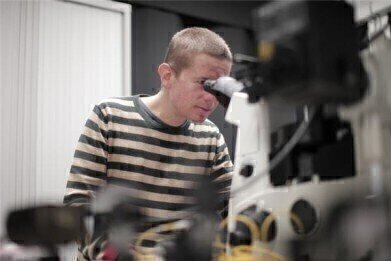-
 Stefan Maier Imperial College, London
Stefan Maier Imperial College, London
News & Views
T-rays potential for medical scanners
Mar 21 2012
Researchers who have developed a new way to create electromagnetic Terahertz (THz) waves or T-rays - the technology behind full-body security scanners – have said the break-through could help develop smaller, more portable, easier to operate and much cheaper hand-held medical scanning gadgets.
Scientists from the Institute of Materials Research and Engineering (IMRE), a research institute of the Agency for Science, Technology and Research (A*STAR) in Singapore, and Imperial College London in the UK have been able to concentrate T-rays into a much stronger directional beam than was previously thought possible at room-temperature conditions. The development opens up potential for use of a T-ray scanner and detector as part of the functionality of a portable sensing, computing and data communications device, since the waves are capable of detecting biological phenomena such as increased blood flow around tumourous growths. They can also be used to detect explosives or drugs, for gas pollution monitoring or non-destructive testing of semiconductor integrated circuit chips.
Future scanners could also perform fast wireless data communication to transfer a high volume of information on the measurements it makes.
Lead author Dr Jing Hua Teng, from A*STAR’s IMRE, said: "The secret behind the innovation lies in the new nano-antenna that we had developed and integrated into the semiconductor chip." Arrays of these nano-antennas create much stronger THz fields that generate a power output that is 100 times higher than the power output of commonly used THz sources that have conventional interdigitated antenna structures. A stronger T-ray source renders the T-ray imaging devices more power and higher resolution.
Research co-author Stefan Maier, a visiting scientist at A*STAR’s IMRE and Professor in the Department of Physics at Imperial College London, said: "T-rays promise to revolutionise medical scanning to make it faster and more convenient, potentially relieving patients from the inconvenience of complicated diagnostic procedures and the stress of waiting for accurate results. Thanks to modern nanotechnology and nanofabrication, we have made a real breakthrough in the generation of T-rays that takes us a step closer to these new scanning devices. With the introduction of a gap of only 0.1 micrometers into the electrodes, we have been able to make amplified waves at the key wavelength of 1000 micrometers that can be used in such real world applications."
The research was led by scientists from A*STAR’s IMRE and Imperial College London, and involved partners from A*STAR Institute for Infocomm Research (I2R) and the National University of Singapore. The research is funded under A*STAR’s Metamaterials Programme and the THz Programme, as well as the Leverhume Trust and the Engineering and Physical Sciences Research Council (EPSRC) in the UK.
Digital Edition
Lab Asia 31.2 April 2024
April 2024
In This Edition Chromatography Articles - Approaches to troubleshooting an SPE method for the analysis of oligonucleotides (pt i) - High-precision liquid flow processes demand full fluidic c...
View all digital editions
Events
May 05 2024 Seville, Spain
InformEx Zone at CPhl North America
May 07 2024 Pennsylvania, PA, USA
May 14 2024 Oklahoma City, OK, USA
May 15 2024 Birmingham, UK
May 21 2024 Lagos, Nigeria









.jpg)







